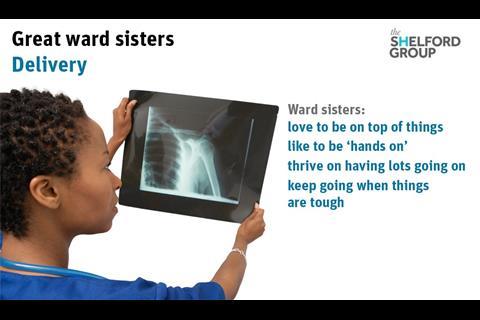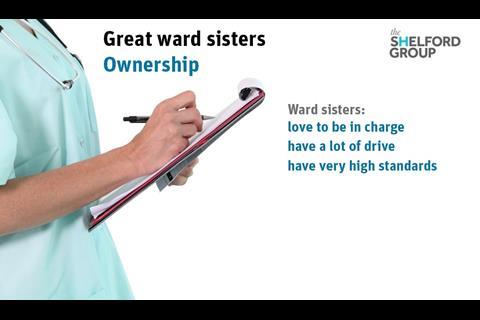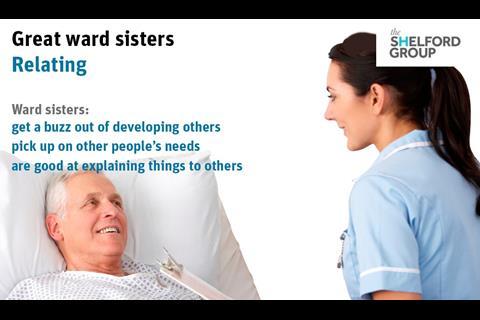By using a clearly defined profile of a “great ward sister” in recruitment, we can restore public faith in the nursing profession, says Katherine Fenton
The old man knew he was dying and so did the ward sister. He had no friends to talk to and no family to sit with him and hold his hand. All he had was a dog and a cat, so the ward sister arranged to have his dog brought in to keep him company.
It was against the rules but the need to do the right thing by the old man was more important to her, so she went ahead and broke them. She got in trouble for it but said she would do it again if it were the right thing for her patient.
‘By appointing the right people in the first place we can restore public faith in the nursing profession and the NHS’
This true story illustrates two of the 13 strengths that this ward sister, and all other great ward sisters, has: “doing the right thing” and “making a difference”. It demonstrates how we are now able to identify nurses with the potential to become great ward sisters.
This is not simply a tactical HR issue to improve recruitment processes, but a strategic issue for the NHS as a whole and one that makes a significant contribution to Compassion in Practice, the vision and strategy for nursing, particularly in action areas 4 and 5 (“building and strengthening leadership”; and “ensuring we have the right staff, with the right skills, in the right place”).
By appointing the right people in the first place and improving patient outcomes, we can fulfil our primary duty and restore public faith in the nursing profession, and by extension, the NHS.
The making of a great ward sister
The project began in conversations between the 10 Shelford Group chief nurses, who work at the biggest academic teaching hospital trusts in England, about what constituted great care and patient experience. How could we know that we were selecting the right ward sister?
Current methods focused almost entirely on experience, competencies and, increasingly, values based assessments.
We felt this was not enough to really identify what made the good ones great, even though we could not articulate it. It was worth remembering that “experience” (time served) did not mean they were great; “competent” means “adequately qualified”. So we knew we needed something more, especially in the glare of the spotlight thrown on to the profession by the Francis report.
Private sector success
We approached a consultancy specialising in the field of strengths based recruitment. This method has been very successful in the private sector in a number of organisations such as Allied Healthcare, Morrisons and Saga.
At its simplest, strengths based recruitment is about recruiting people with the innate strengths and motivators to love the job they are doing. Together we agreed on a plan to create a profile of the “great ward sister” that we could clearly articulate and use for candidate selection.
‘We distilled the information and developed the profile: 13 strengths emerged and every ward sister who participated demonstrated each one.’
Ten ward sisters were chosen from different wards, one from each trust whom we agreed were “great”. The consultancy spent a day with each sister, working with them, following them around and asking them lots of questions. Their matron and line manager were also interviewed.
They then distilled this information and developed the profile: 13 strengths emerged and every ward sister who participated demonstrated each one.
Caring is a collection of values
“Caring” did n0t emerge in the profile. It is a surprising finding, and perhaps counterintuitive, until we understand that “caring” is an umbrella term for a collection of more specific values.
‘Doing the right thing for their patients is so important that nurses will break the rules if they feel they have to’
For example, one of the core strengths all the ward sisters shared was the absolute need to do the right thing. These people are not rule breakers by nature, nor are they naturally assertive; they are modest and self-effacing.
But because doing the right thing for their patients is so important, they will break the rules if they feel they have to (always ensuring patient safety is not compromised) − they just don’t enjoy doing it.
Profiling our ward sisters
Having created the profile we could instantly start using it in our selection of ward sisters. First, for comparison, here is part of a traditional recruitment advert for a ward sister:
“We are looking for a nurse who is committed to the delivery of compassionate high quality care. We promise that we will guide your development with a comprehensive development programme. You will be leading a team of registered and unregistered members of the workforce. You will need to lead by example by having a clinical presence within the department.”
And here’s how we summed up the profile in a recruitment ad for a senior ward sister post:
“Is providing excellent nursing care and getting the basics right one of your deepest beliefs? Do you love developing others to become excellent at what they do? Is making a difference and doing the right thing fundamental to you? If your answer to these questions is yes, the ward sister/charge nurse role may be right for you.”
The language reflects the profile and will attract and filter out suitable and unsuitable candidates; those who fit the profile recognise themselves in the description.
A new way of recruiting
Creating the profile was only the start of the process. Next came strengths based recruitment training.
Recruiting for strengths is a completely different way of recruiting from what we do now. It is more difficult but it only takes an hour.
‘Reading body language and tone of voice can filter out those trying to give “the right answer”’
Specific two day training was given to cohorts of HR managers, ward sisters and matrons: from reading body language and tone of voice, to calibrating interviewees’ responses to filter out those trying to give “the right answer”.
Recruiting to the profile
The Shelford Group chief nurses are already starting to see impressive results from recruiting to the profile.
At University Hospitals Birmingham and University College London Hospitals foundation trusts, a number of people have been trained to do the selection and aim to use the profile for all ward sister and junior ward sister posts.
As part of restructuring at Imperial College Healthcare Trust, director of nursing Janice Sigsworth and her colleagues interviewed 50 ward sisters. Using the profile they identified nurses who were suited to manage both intensive and non-intensive wards.
Define a great ward sister
A person either has these strengths or not, they cannot be developed. This does not mean if a person does not have all 13 strengths they are not a great nurse; it does mean that they will not be a great ward sister − they are not the right fit.
‘Does the profile completely replace interviewing for competencies? No. We still need to ensure that our ward sisters possess the necessary skills’
Senior nurses at all 10 organisations, as well as HR colleagues, have received this approach really positively. They ask challenging questions, as critical friends should, but nobody has denied the potential of the profile.
At a briefing for 50 HR people and nursing staff at Sheffield Teaching Hospitals Foundation Trust not one person opposed the idea.
Does it completely replace interviewing for competencies? No. We still need to ensure that our ward sisters possess the necessary skills.
But the sequence of filters now runs as follows:
- interview against values;
- interview against the profile; and
- interview against competencies.
In this way, only the candidates who have already met the standards demanded by the profile go forward to be asked about their competencies. This greatly reduces the risk that we recruit people who, while qualified to do the job, do not match the profile of someone who will love doing, and perform excellently in, the job.
Moving beyond the post
With the great ward sisters profile now in use at the Shelford Group teaching hospitals, the next phase of the project is to look at how we replicate our successes − and not just with ward sister posts.
As a next step we will develop a profile we can use when selecting staff nurses, potential student nurses and nursing assistants. The work will start this year.
‘We will develop a profile we can use when selecting staff nurses, potential student nurses and nursing assistants’
The strengths based recruitment approach to selecting nurses and ward sisters directly supports chief nursing officer Jane Cummings’s goal of ensuring that “essential nursing care is a given and can be counted on every time, in every healthcare setting”.
Transform NHS care
Whenever you run a major project such as the great ward sisters profile, there is a risk that some people will see it as a discrete entity, something that can be done, reported on and then parked while everyone gets on with business as usual.
‘If we want to transform care then we have to make sure that we have the right people to do it’
But the nursing profession, the NHS nor the public at large and their elected representatives have any appetite for business as usual.
They want us to change. We want to change. These profiles are just the first step in a journey that has the potential to transform care in the NHS.
If we want to transform care then we have to make sure that we have the right people to do it.
Katherine Fenton is chief nurse at University College London Foundation Trust





























1 Readers' comment